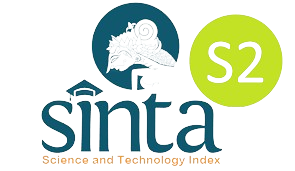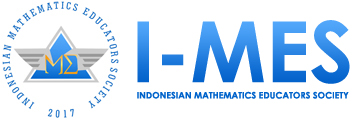Pemecahan Masalah Matematis Siswa Kelas VIII Menggunakan PMRI melalui LSLC pada Materi Gradien
DOI:
https://doi.org/10.29408/jel.v6i2.2214Keywords:
gradient, LSLC, mathematical problem solving, PMRIAbstract
This study aims to discover how the mathematical problem-solving ability of students in class VIII using Pendidikan Matematika Realistic Indonesia (PMRI) through Lesson Study for Learning Community (LSLC) on straight-line gradient material. The subjects of this Study were Students of class VIII.B Srijaya State Junior High, totaling 32 students. The learning process takes place adapted to the principles and characteristics of PMRI through the LSLC system. Data collection the techniques used in this study were observation, written tests consisting of two problem descriptions, and interviews conducted to obtain supporting data. The observation was to see student activities during the learning process. The tests are conducted to find out how students mathematical problem-solving abilities. The interview is used to confirm the student's answers. Obtained students' mathematical problem-solving abilities on the Straight-Line Gradient subject and had reached the indicators of understanding the problem, planning solutions, and implementing plans with the most indicators often appear is the indicator of planning a solution. In contrast, the indicator that rarely appears is the indicator of the truth of the completion of the problem. The conclusion of this research is mathematical problem solving of 8th-grade students using PMRI through LSLC on gradient material category was enough.
References
Bariroh, N. M., Triyanto, & Setiawan, R. (2018). Eksperimentasi model pembelajaran cooperatif think talk write dengan pendekatan scientific pada materi PGL ditinjau dari gaya berpikir siswa kelas VIII SMP Negeri 17 Surakarta. Jurnal Pendidikan Matematika dan Matematika (JPMM). 2(4), 289-290.
Idris, I., & Desri, K. S. (2016). Penerapan pendekatan PMRI untuk meningkatkan kemampuan penyelesaian soal cerita pada kelas VII A SMP UTY. Jurnal Edumatsains, 1(1), 73-82.
Iswahyud, D., & Akba, M. R. (2018). Peningkatan kemampuan komunikasi mahasiswa melalui metode student team achievement division berbasis LSLC. Jurnal Ilmiah Pendidikan Matematika, 8(1), 13-15. https://doi.org/10.21067/jip.v8i1.2174.
Nagle, C. & Moore, R. D. (2013). The concept of slope: comparing teachers concept images and insructional content. Inverstigation In Mathematics Learning, 6(2), 3-5. https://doi.org/10.1080/24727466.2013.11790330.
Nusantara. (2018). Kemampuan representasi matematis siswa pada pokok bahasan gradien garis lurus menggunakan pendekatan PMRI di SMP N 13 Palembang. Indralaya: UNSRI.
Putra, H. D., Thahiram, N. F., Ganiati, M., & Nuryana, D. (2018). Kemampuan pemecahan masalah matematis siswa SMP pada materi bangun ruang. Jurnal Ilmiah Pendidikan Matematika, 6(2), 82-84. https://doi.org/10.25273/jipm.v6i2.2007.
Putri, R. I. I. (2012). Implementasi lesson study melalui pendekatan PMRI pada mata kuliah metode statistika I. KNMXVI, 1-8.
Saleh, A., & Lubis, F. A. (2018) Pengaruh penggunaan model pembelajaran make a match terhadap kemampuan pemecahan masalah materi pokok SPLDV di Kelas VIII SMP N 1 Batang Angkola. Jurnal Education and Development IPTS, 6(1), 20-26.
Sari, N. (2011). Pengembangan materi ajar PGL menggunakan pendekatan PMRI di Kleas VIII SMP. Indralaya: UNSRI.
Sato, M. (2014). Dialog dan kolaborasi di SMP Praktek “Learning Communityâ€. Jepang: JICA.
Sato, M. (2014). Mereformasi sekolah: konsep dan praktek komunitas belajar. Jepang: JICA.
Sumarsih. (2016). Analisis kesulitan siswa SMP dalam mempelajari PGL dan alternatif pemecahannya. Prosiding Seminar Matematika dan Pendidikan Matematika, 415-418.
Stump, S. (1999). Secondary mathematic teachers knowledger of slope. Mathematics Education Reasearch Journal, 11(2), 124-144. https://doi.org/10.1007/BF03217065.
Wahdah, A. H. (2016) Metode bermain peran dengan menggunakan lesson study (guru mitra) sebagai model pembelajaran matematika kelas XII IPA 2 SMA N 1 Guntur. Jurnal Profesi Keguruan, 3(1), 26-28.
Wahyuni, R., Marriyam, & Sartika, D. (2018). Efektivitas model pembelajaran creative problem solving dalam meningkatkan kemampuan berfikir kritis matematis siswa pada materi PGL. Jurnal Pendidikan Matematika Indonesia, 3(1), 26-27. https://doi.org/10.26737/jpmi.v3i1.520.
Widodo, M. S. (2014). Keefektifan pembelajaran matematika dengan pendekatan PMRI pada materi lingkaran di kelas VIII SMP. Jurnal Ilmiah Pendidikan Matematika, 3(3), 125-128.
Zulkardi, & Putri, R. I. I. (2010). Pengembangan blog support untuk membantu siswa dan guru matematika Indonesia belajar PMRI. JIPP Balibang, 4-6.
Zulkipli, & Ansori, H. (2018). Kemampuan pemecahan masalah matematis siswa SMP Muhammadiyah 1 Banjarmasin. Jurnal Pendidikan Matematika, 6(1), 34-36. https://doi.org/10.20527/edumat.v6i1.5118.
Downloads
Additional Files
Published
How to Cite
Issue
Section
License
Authors who publish with the Jurnal Elemen agree to the following terms:
- Authors retain copyright and grant the journal right of first publication with the work simultaneously licensed under Creative Commons Attribution-ShareAlike 4.0 International License (CC BY-SA 4.0).
- Authors are able to enter into separate, additional contractual arrangements for the distribution of the journal's published version of the work (e.g., post it to an institutional repository or publish it in a book), with an acknowledgment of its initial publication in this journal.
- Authors are permitted and encouraged to post their work online (e.g., in institutional repositories or on their website) prior to and during the submission process, as it can lead to productive exchanges, as well as earlier and greater citation of published work.
Jurnal Elemen is licensed under a Creative Commons Attribution-ShareAlike 4.0 International License





